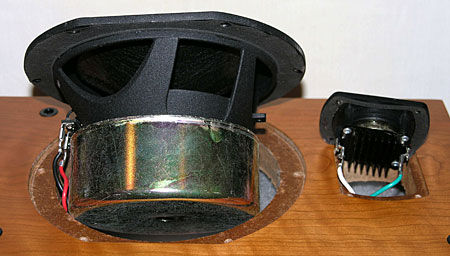Aperion Audio Intimus 633-T Surround Speaker System Page 2
You can see the two drivers in the accompanying photo. With its heavy cast frame and shielded magnet, the woofer looks very substantial. The tweeter is tiny—its small magnet is definitely neodymium. There is no magnetic shielding on the tweeter, but there is a heat sink on the back of the magnet. Barely visible in the photo is a thin, soft strip of foam on the inside of each speaker's flange to provide a tight seal to the cabinet.

Though I could only see a cross section of the front baffle with the drivers removed, the cabinet walls appear substantial (Aperion says they are 25mmn thick—or about 1"). A cross-brace behind the woofer also supports the back of the port. The crossover was hard to see in detail because of its location, though it appears relatively substantial and complex for such a small, inexpensive speaker. I can't imagine how it could be removed in the unlikely event that service is ever needed. It's mounted on the lower side of the cabinet, and it looks like it was screwed to the cabinet wall before the enclosure was fully assembled—the proverbial crossover-in-a-bottle.
The only reservation I have about the design (apart from that inaccessible crossover) is the thin and skimpy internal damping material. For all I know that might be the best arrangement for this specific design, but I couldn't help but wonder if loosely filling the entire cabinet with an appropriate damping material might further improve the speaker's performance.
(A lot of audiophiles love to hot rod their components, and the Aperions, with their apparent "good bones"—an attractive price, beautifully built and finished cabinets, and quality drivers—are certainly tempting candidates. But those tight-fitting drivers and well-buried crossovers will make it a challenge—not to mention, of course, that you can probably kiss your warrantee goodbye.)
In Action
The Aperion samples that I received—at least the 633-Ts—had been used in at least one hi-fi show and were already well broken in by the time they arrived at my studio. I began my evaluation, as I often do, by setting up just the 633-Ts, operating full-range in two-channel mode, in my small-room system. In this modest, 13' x 16' x 8.5' room, driven by an Outlaw 1050 receiver, they sounded very neutral. When I sat down for the first listening session I intended to spend an hour or so with the speakers, listening to a few of my reference CDs. I ended up listening for nearly three hours, searching around for favorite recordings to play. That's always a good sign.
Even with a big CRT rear projection TV squatting between them the 633-Ts produced a sharp, well-defined center image with very respectable (though not startling) depth. The balance was even-handed. The highs sparkled, and if they were just little short of openness and air, that Outlaw receiver, to be fair, also leans the same way. The midbass to midrange region, particularly singing voices, were notably free of any clearly recognizable colorations—no nasality, chestiness, or bloat. The sound was just a little forward on much of the program material I listened to, but just enough to give the sound a pleasant but never grating immediacy. And the bass, while not subterranean, never sounded obviously limited on anything but the most challenging music like huge organ pipes and hyperactive synthesizers.
After a few days the time came to move the 633-T system into my larger home theater space (just over 3000 cubic feet). The 633-Ts were set flanking my projection screen at the left and right, and were toed-in so that their axes crossed just in front of the main (center) listening seat. The 533-VAC center channel was on a short stand below the screen, aimed upward with its centerline about 16-inches above the floor. The two 632-LRs, used as surrounds, were placed on 24" high stands near the back of the room.
Rather than change all of the speakers in the system at once, I elected to keep the Revel B15 subwoofer in the system for the first go-round of listening tests. The Revel's parametric equalizer has been set to provide relatively even bass response with the sub positioned in the right front corner of the room, and I didn't want any surprises from a new, unequalized subwoofer to distract me from evaluating the basic sound quality of the Aperion system until I became familiar with its capabilities. The B15, it must be said, costs more than half again as much as the entire, sub-less Aperion system. But the Revel and Aperions blended very nicely.
I began, as before, with two-channel music, but this time with the Revel sub taking over below 80Hz. The sound continued to make a very favorable impression, with the added benefit of a larger room, a first-rate subwoofer, and more powerful, upscale system at the front end providing a big, dynamic sound.
- Log in or register to post comments






























































